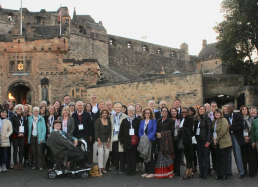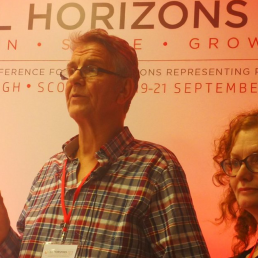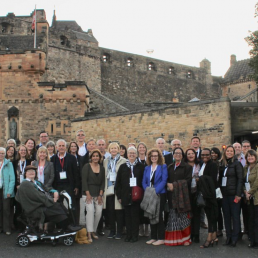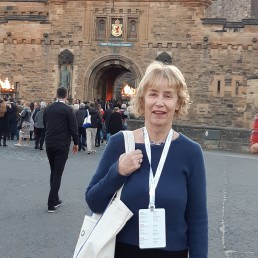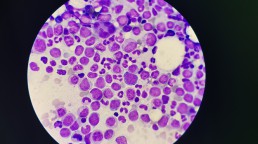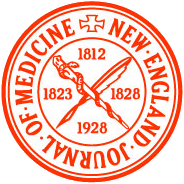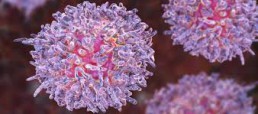CLL Horizons and workshop – an update
CLL Horizons and workshop – an update
I’ve just returned from attending two back-to-back conferences on CLL in Edinburgh. The first was the international CLL Advocates Network (CLLAN) Horizons conference for CLLAN members. The second was the 2019 International Workshop on CLL (iwCLL), a major medical and scientific meeting. Both conferences were excellent.
Horizons focused on CLL patient advocacy group models from around the world, what made them work, where improvements could be made, and where the future was heading. There was a lot of discussion on sharing of resources amongst the various groups, so as not to “reinvent the wheel”, and you will soon see examples of this here on our site.
Psychosocial support provision, use of social media to communicate among individuals and groups, examples of successful advocacy, and the various ways in which advocacy groups can make positive contributions to research were major components of the formal presentations. There were also several presentations about the current state of the science and medical therapeutics of the disease CLL.
I was invited to present the story of a new advocates’ group, on how we’re developing CLLANZ and lessons learned, as well as the future role of the organisation. Click below to view my presentation.
The iwCLL meeting (attended by close to 2000 delegates) covered in great detail the science and the medicine of CLL in 2019, and the directions investigative science and medical therapeutics will take in the next few years.
I will be sharing specific aspects of interest from the conference presentations with you on this website , over the next few weeks, linked to areas of research and treatments
Best wishes

Neil Graham
Submission to Pharmac to call for a revision of CLL treatment decision
Submission to Pharmac to call for a revision of CLL treatment decision
Dr Neil Gram writes on behalf of CLL patients to ask Pharmac to revise the decision to fund only venetoclax for the treatment of CLL, by funding ibrutinib as an essential treatment for CLL, in addition to venetoclax. While we welcome the fact that a new era treatment for CLL has at last been funded, we have serious concerns about the limitations of the chosen medicine and its inability to meet the needs of all CLL patients, in particular those with severe CLL.
Click here to view the letter sent to Pharmac on 12 September 2019
New Therapies for Blood Cancers Hold Promise
New Therapies for Blood Cancers Hold Promise
This article was originally published on BioSpace
Blood cancer is actually a term applied to three different types of cancer – leukemia, lymphoma and myeloma. For centuries, these cancers had virtually no possibility of survival. Even as recently as the 1960s, the five-year survival rate for leukemia was 14%. By 2010, it had increased to 61%. Similar gains have been made in the survival rates for lymphoma and myeloma, with Hodgkin lymphoma reaching a five-year survival rate of 88% in that year. The story of the science behind the gains in survival rates and the development of ever-more effective therapies is the story of advances in the field of immunotherapy and personalized medicine taking place at centers such as Abramson at UPENN and Dana-Farber in Boston.
Bone Marrow Transplants
The first significant increases in survival rates occurred in the early 1980s, with the introduction of chemotherapy and bone marrow transplants. In a UPENN CureTalks interview in 2017, Dr. Carl June of UPENN described the two-step process. First, the patient’s immune system received super-lethal doses of chemotherapy. Then, bone marrow from a sibling was transplanted into the patient. When the result was a better survival rate, the increase in survival was attributed to the super-lethal dose of chemotherapy administered prior to the transplant. When the procedure was performed on identical twins and researchers discovered that increased survival did not occur, researchers had to rethink their premise. They realized that the source of the survival increase lay in the differences in the marrow of the non-identical sibling rather than in the process of destroying the patient’s immune system before the introduction of new bone marrow.
This better understanding of the cause of increased survival rates from bone marrow transplant therapy, combined with the significant downside arising from graft vs host disease, led June to explore the possibility that patients could receive the benefits of a bone marrow transplant without an actual transplant. He studied the possibility that a patient’s own immune system could be used as a weapon. The outcome of this work was the development of CAR-T cells, approved for use by the FDA in 2017.
CAR-T
CAR-T therapy is the first personalized cancer therapy to be approved by the FDA. The process has been licensed by Novartis. They have manufactured CAR-T cells for patients in their FDA-approved facility. With CAR-T, a patient’s own T-cells are filtered, along with white blood cells, through the leukapheresis process. A viral vector is used to recognize the targeted cells – cells with cancer and other cells expressing a specified antigen. These “reprogrammed” cells are then introduced back into the patient’s blood.
According to June, it is not at all uncommon for a high fever to occur during the time when the CAR-T cells are annihilating the cancer cells. This fever has shown no lasting effect. It is a side effect that indicates that the process is working. For two of the first three participants in the clinical trials held at Penn in 2010, the survival rate for chronic lymphocytic leukemia (CLL) was eight years as of 2018.
Immune Checkpoint Inhibitors
Another FDA-approved immunotherapy agent is used in patients with recurring Hodgkin lymphoma (HL). The FDA approval occurred in 2016, but a study underway in 2019 at Dana-Farber by Dr. Margaret Shipp’s team is investigating the mechanism that causes two proteins, PD-L1 and PD-L2, to overproduce on HL cells. They’ve found that the proteins work with a protein on the T-cells that keeps the T-cells from attacking the HL. By blocking PD-1, it is possible to expose the HL to the T-cells. The use of these checkpoint inhibitors holds promise for those with HL that has reoccurred or not responded to the first therapy.
BiTE
Until recently, a patient’s immune system was reprogrammed to fight a single target – an antigen. Dr. Daniel D’Angelo of Dana-Farber describes BiTEs (bispecific antibodies) as a way to cut out the middle step. Rather than attack first one, and then the other, the BiTE attaches to both a T-cell and a tumor cell at the same time. This FDA-approved therapy is being used to treat acute lymphoblastic leukemia (ALL) but shows potential for the treatment of other cancers.
The potential advantage of BiTEs over CAR-T cell therapy lies in the fact that BiTEs are not patient-specific: There is not the need to remove and reprogram T-cells for reintroduction into the patient’s blood. Currently, BiTE is being used with patients who have multiple myeloma (MM) and have relapsed. Early results are promising. In one clinical trial, some patients showed no trace at all of cancer after treatment. The next step is to see how long this remains the case, as well as whether or not different delivery times or the use of BiTE in conjunction with CAR-T will make a difference in the outcome.
Under Study
At the ASH Annual meeting held at Abramson Cancer Center, two new studies were described.
One study is designed to determine the best time to introduce CAR-T therapy in multiple myeloma (MM). It will identify T-cell biomarkers that help to predict the outcome from CART-BCMA therapy (Abstract #1974 and Abstract #1886). The other explores the combination of CAR-T cells and the tyrosine kinase inhibitor ibrutinib in chronic lymphocytic leukemia (CLL). Initial results show that the use of both in combination will lead to deep and sustained remission (Abstract #298).
The current work is already leading to new avenues of investigation. Improved blood cancer therapies are one part of the advances being made in targeted, personalized therapies.
Ibrutinib Combo in Chronic Lymphocytic Leukemia is Superior, but Costly
Ibrutinib Combo in Chronic Lymphocytic Leukemia is Superior, but Costly
This article was originally published on the Cancer Network
In the first-line setting, ibrutinib plus rituximab had a superior survival benefit to standard chemoimmunotherapy for patients with chronic lymphocytic leukemia (CLL), according to an interim analysis of a phase III randomized clinical trial published in the New England Journal of Medicine.
Study researchers also noted that “indefinite” use of ibrutinib therapy has been associated with “substantial expense.” According to the IBM Micromedex, the estimated average wholesale price per month for ibrutinib alone is more than $13,324. A 2018 study found that at current prices, ibrutinib was not cost-effective as first-line treatment for CLL patients older than 65 years of age with a 17p deletion.
The trial enrolled 529 patients between March 2014 and June 2016 who were 70 years of age or younger with treatment-naïve CLL. Patients were randomly assigned in a 2:1 ratio to receive either 6 cycles of ibrutinib plus rituximab followed by continuous administration ibrutinib until disease progression (n=354) or 6 cycles of standard chemoimmunotherapy (n=175), which consisted of fludarabine, cyclophosphamide, and rituximab. Follow-up was a median of 33.6 months.
At 3 years, patients who received ibrutinib plus rituximab had a statistically higher progression-free survival (PFS) rate and 65% lower risk of disease progression or death compared with patients who received standard chemoimmunotherapy (89.4% vs 72.9%; HR=0.35; 95% CI, 0.22–0.56; P<0.001). Patients who received ibrutinib plus rituximab also had a significantly higher overall survival (OS) rate and an 83% lower risk of death compared with patients who received standard chemoimmunotherapy (98.8% vs 91.5%; HR=0.17; 95% CI, 0.05–0.54; P<0.001).
Overall, both the ibrutinib plus rituximab and chemoimmunotherapy groups had approximately an 80% incidence of adverse events of grade 3 or higher. There was, however, a difference in infection complications of grade 3 or higher, with the ibrutinib plus rituximab group having a lower incidence compared with the chemoimmunotherapy group (10.5% vs 20.3%; P<0.001).
The incidence of adverse events of grade 3 or higher (regardless of attribution) was similar in the two groups (in 282 of 352 patients [80.1%] who received ibrutinib–rituximab and in 126 of 158 [79.7%] who received chemoimmunotherapy), whereas infectious complications of grade 3 or higher were less common with ibrutinib–rituximab than with chemoimmunotherapy (in 37 patients [10.5%] vs. 32 [20.3%], P<0.001).
“I don’t think one hundred percent of people should be getting ibrutinib as frontline therapy,” Joshua Brody, MD, director of the Lymphoma Immunotherapy Program at the Icahn School of Medicine at Mount Sinai Hess Center for Science and Medicine in New York, told Cancer Network.
On the basis of the study results, he explained the ibrutinib combination is “definitely” a “reasonable” option and “better” than fludarabine, cyclophosphamide, and rituximab, but it’s not “definitely” better than rituximab plus bendamustine, which is the other chemoimmunotherapy regimen commonly used in this patient population.
A previously published trial in treatment-naive CLL patients found a PFS benefit among those who received ibrutinib monotherapy or ibrutinib plus rituximab when compared with rituximab plus bendamustine. However, no OS benefit was seen for the ibrutinib-containing regimens.
Government unveils national cancer agency and $60 million injection into Pharmac
Government unveils national cancer agency and $60 million injection into Pharmac
This article was originally published on the New Zealand Herald
The Government has today unveiled plans to establish a national cancer agency, which will be led directly by experts of the deadly disease, and a $60 million injection into Pharmac.
Key announcements:
• Cancer Control Agency to abolish postcode lottery.• World-leading public health physician and cancer epidemiologist Professor Diana Sarfati has been appointed as the Ministry of Health’s interim National Director of the cancer control agency.
• A $60 million funding boost to Pharmac, $20 million this year and $40 million in 2020/21.
• A new system to fast-tracking Pharmac’s drug funding decision process.
Until today, decisions about how to tackle New Zealand’s cancer “crisis” came from bureaucrats within the Ministry of Health.
By December 1, the Government has promised decisions will come from a team of top cancer specialists who will report directly to Health Minister David Clark. That is the date the agency will officially be up and running.
World-leading public health physician and cancer epidemiologist Professor Diana Sarfati has been appointed as the Ministry of Health’s interim national director of the agency.
“This is huge for New Zealand. It’s the biggest change in cancer care in at least 15 years, if not ever. When the UK appointed a national cancer director there was an unprecedented improvement and survival rates increased dramatically,” Cancer Society of New Zealand medical director Chris Jackson said.
It comes after a powerful public movement started by dying dad Blair Vining who launched a petition calling for a national cancer agency to hold District Health Boards to account and put an end to postcode lottery.
His petition gained more than 140,000 signatures from New Zealanders across the country.
One of the main aims of the plan is to have equitable cancer survival rates across New Zealand by 2030 – including across geographic areas and across ethnicities. Māori cancer outcomes will be one of the first priorities as Māori have higher rates of cancer and poorer survival rates overall.
Funding decisions will be made with an “equity first” methodology, the plan says.
For example, the national bowel screening programme, which is still being rolled out, makes screening free for people aged 60-74.
But because Māori people tend to develop bowel cancer at an earlier age, the plan suggests the screening programme could be made free for Māori ten years earlier, between the ages of 50-74.
Another aim is for New Zealanders to suffer from fewer preventable cancers.
Lung cancer is the top of the list, with prevention strategies including promotion of vaping and the finalisation of a Smokefree 2025 Action Plan.
The plan also highlights improved detection and management of Hepatitis A, B and C, reducing HIV transmission, increasing the uptake of the HPV vaccine and addressing Helicobacter pylori infection in priority populations.
Skin cancer will also be a target, with promotion of sun safety – particularly among children – and sunscreen could also be regulated as a therapeutic product, the plan says.
A programme will also be developed to prevent work-related cancers.
Another aim of the plan is to improve survival rates once people have cancer, with an emphasis on better, earlier screening, and improved treatment once diagnosed.
Strategies including increasing the age of free breast screening from 70 to 74 years old, progressing the national bowel screening programme and exploring bringing in HPV screening as part of the cervical screening programme.
The radiation and oncology workforce could also see a boost to its workforce and resources.
Fast-track diagnostic pathways will be developed for “priority cancers”, and there would be a national agreement on the scope and distribution of specialist cancer services.
“Quality performance indicators” will be introduced under the plan to ensure specific cancers are being diagnosed and treated consistently across New Zealand.
Bowel cancer has been used as a test case for QPIs with the first results published for diagnosis and treatment in March this year. The Bowel Cancer Quality Improvement Report compared DHBs on measures such as death rate after surgery, length of stay in hospital and where at least 12 lymph nodes were examined.
By early 2020 prostate, lung and neuro-endocrine tumours will also have similar reports published.
Health Minister Dr David Clark said the Government has listened to calls for strong central leadership and will deliver the promised Cancer Control Agency by December 1, 2019.
“Cancer care is woven into so much of the work that our public health service does, so while the agency will have its own chief executive, it makes sense for it to be housed within the Ministry of Health.
“I’m also pleased to announce that leading public health physician and cancer epidemiologist Professor Diana Sarfati has been appointed interim National Director of Cancer Control, starting immediately. She will lead work to improve the quality of treatment.
“An immediate priority will be establishing quality performance indicators for specific cancer types. This will mean we can measure progress towards consistent care across DHBs.
“We are also combining the four current regional cancer control networks into a National Network to help remove regional variations in care,” Clark said.
More Pharmac funding welcomed
Pharmac has welcomed the $60m funding injection, which includes $20m for this year and $40m for 2020/21. That’s on top of $10m announced in this year’s Budget.
That brings Pharmac’s annual medicines budget to over $1 billion, Pharmac board chair Steve Maharey said.
In last year’s Budget, the Government increased Pharmac’s funding by more than 13 per cent, from about $870m to $985m. That compares to increases of 2.4 per cent and 6.3 per cent in National’s last two years in government.
Pharmac announced this afternoon it was proposing to funding three new medicines to treat ovarian cancer (olaparib, known as Lymparza), breast cancer (fulvestrant, known as Faslodex) and leukaemia (Venclexta – used to treat chronic pymphocytic leukaemia).
It is also proposing making contraceptives Mirena and Jaydess available to more people, and making the meningococcal ACWY vaccine free for people in close living situations like hostels and army barracks.
The medicines could be available from November if consultation feedback is positive.
Pharmac said it was also looking to get the best deal for New Zealanders for a particular type of advanced breast cancer.
Two registered medicines palbociclib (Ibrance) and ribociclib (Kisqali) could be suitable, experts believe.
Pharmac said it had issued a request for proposals and one of these medicines could be available from April next year.
Prime Minister Jacinda Ardern said from next year Pharmac will also speed up its decision-making by considering applications for funding while Medsafe assesses the safety of new medicines.
“Rather than waiting until that work is complete as it does currently. Work on options for early access to new cancer medicines is also progressing well,” Ardern said.
New Zealand’s history of tackling cancer:
1999
– Labour Government announces plans are under way for first ever cancer plan.
2003 – Cancer control strategy released included cancer prevention, screening, early detection, treatment, rehabilitation, support and palliative care.
2005 – Labour Government establishes national agency known as Cancer Control Council, formally Cancer Control of New Zealand, to provide independent advice free from political interference.
2014 – National Party-led Government introduces three-year cancer plan, including a faster cancer treatment target requiring most patients to start treatment within 62 days of diagnosis.
2015 – National disestablishes Cancer Control Council, saying it is no longer necessary as it has been superseded by new plan.
July 2017 – Pre-election, Labour promises to set up a National Cancer Agency, with $10 million to establish the agency and a further $10m to get work under way.
2018 Labour-led Government ends public reporting of DHBs’ faster cancer treatment target results, although the data is still collated.
Jan 31, 2019 – Melissa Vining blasts Health Minister David Clark for not following through on promise to establish cancer agency.
Clark announces the Government’s plan to tackle cancer is under way and he expects to see a draft by the end of June.
May 6, 2019 – Herald starts investigation revealing hundreds of Kiwi cancer sufferers have received large taxpayer-funded payouts after being let down by the public health system.
June 28, 2019 – Blair Vining launches petition calling for a national cancer agency to hold District Health Boards to account and improve the health care system.
June 29, 2019 – Herald reveals Prime Minister’s letter to Blair’s daughter Lilly Viningsuggesting agency is not part of the Government’s plan.
More than 650 New Zealanders gathered in Invercargill to join Vining as he handed over a petition to National’s Michael Woodhouse.
July 7, 2019 – Vining’s petition closes to the public.
Today – Government’s unveils plans to establish a national cancer agency lead by experts of the deadly disease.
New Study Reports “Curative Potential” of a Combination Therapy for Some Leukemia Patients
New Study Reports “Curative Potential” of a Combination Therapy for Some Leukemia Patients
This article was originally published on Dana-Farber Cancer Institute
Chemoimmunotherapy combined with a targeted drug given for two years has achieved undetectable minimal residual disease (MRD) for a high proportion of younger patients with chronic lymphocytic leukemia (CLL), Dana-Farber scientists report.
The phase 2 clinical trial results are so favorable that they represent a step toward “a new standard of care with curative potential for a broad population of younger, fit patients” with CLL, say the investigators, led by Matthew Davids, MD, MMSc, and Jennifer Brown, MD, PhD. “Younger” in this setting is 65 years of age or below.
The report in The Lancet Haematology describes the regimen administered to 85 patients with CLL whose median age was 55 years. The study looked at individuals whose cancer carried a mutated IGHV gene — which confers a higher likelihood of a long-lasting response to chemotherapy — and those with an unmutated IGHV gene — who rarely have durable responsesto chemotherapy.
The study examined the combined effect of two different treatment options for CLL patients. The first, chemoimmunotherapy consisting of fludarabine, cyclophosphamide, and rituximab (FCR), can improve overall survival for younger fit patients with CLL who have an IGHV mutation. The second, the targeted drug ibrutinib, can be effective for CLL patients irrespective of their IGHVstatus, but requires continuous treatment. The clinical trial examined if FCR plus time-limited ibrutinib could achieve long-lasting responses in younger, fit patients with either mutational status.
The patients, who were previously untreated, received oral ibrutinib for seven days, then up to six 28-day cycles of FCR along with continuous ibrutinib. Responders continued on maintenance ibrutinib for up to two years, and those who had undetectable MRD in bone marrow after two years were able to stop treatment.
Thirty-three percent of patients achieved the primary endpoint — a complete response with undetectable minimal residual disease in bone marrow two months after the last cycle of ibrutinib plus FCR. A best response of undetectable minimal residual disease in bone marrow was achieved by 84 percent of patients at any time during the study. “Many of the patients had deepening responses while on the two years of ibrutinib maintenance, so later converted to undetectable MRD,” explains Davids.
The researchers say the results of the trial demonstrated that the combination of chemotherapy and two years of ibrutinib maintenance leads “to the best of our knowledge, to the highest proportion of patients achieving undetectable minimal residual disease in the bone marrow ever published for any regimen used to treat this disease.” The approach, they add, could increase the potential to “functionally cure patients with mutated IGHV and, importantly, might for the first time extend this potential to patients with unmutated IGHV.”
Survival increased in chronic lymphocytic leukemia patients treated with ibrutinib and rituximab
Survival increased in chronic lymphocytic leukemia patients treated with ibrutinib and rituximab
This article was originally published on 2 minute medicine
1. Previously untreated chronic lymphocytic leukemia (CLL) patients experienced increased progression-free and overall survival when treated with ibrutinib-rituximab compared to current standard chemoimmunotherapy.
2. Rates of high grade adverse events were similar between treatment groups.
Evidence Rating Level: 1 (Excellent)
Study Rundown: CLL is a common hematologic malignancy often treated with a combination of fludarabine, cyclophosphamide, and rituximab. While efficacious, there are notable side effects to the chemoimmunotherapy regimen. The Bruton’s tyrosine kinase (BTK) inhibitor ibrutinib has shown efficacy in patients with relapsed or refractory CLL, though how it performs as a first line treatment is not yet determined. This phase 3 trial evaluated ibrutinib-rituximab in comparison to standard chemoimmunotherapy in untreated CLL patients and found both progression-free and overall survival to be improved relative to standard therapy at almost 3 years after treatment initiation. The incidence of grade 3 or 4 adverse events was similar in the treatment groups, though infections were more common in the ibrutinib-rituximab group.
This randomized trial provides support for use of a new regimen as a first line treatment in CLL patients. Strengths of the study include its randomized design, mutational analysis of immunoglobulin heavy-chain variable region (IGHV) patients, and extensive subgroup analysis. The utility of this study is limited by its discordance with other trials evaluating ibrutinib in CLL.
Cirmtuzumab-Imbruvica Combo Trial Enrolling CLL, SLL Patients for Phase 2
Cirmtuzumab-Imbruvica Combo Trial Enrolling CLL, SLL Patients for Phase 2
This article was originally published on Lymphoma News Today
Following promising early efficacy results for a cirmtuzumab–Imbruvica treatment combo, a Phase 2 clinical trial has now been opened to people with chronic lymphocytic leukemia/small lymphocytic lymphoma (CLL/SLL).
The opening of this randomized trial was based on the promising results seen in the prior Phase 1 stage, in which 100% of the first nine CLL/SLL patients responded to treatment with Oncternal Therapeutics‘ investigational therapy cirmtuzumab in combination with Imbruvica (ibrutinib).
The Phase 2 clinical trial is now open to an additional 90 patients with CLL/SLL. Participants will be randomly selected to receive the combination of cirmtuzumab plus Imbruvica, or Imbruvica alone. More information on enrollment can be found on the trial’s page here.
Imbruvica, by Janssen and AbbVie, is the standard of care for people with CLL/SLL and mantle cell lymphoma (MCL) who have received at least one prior therapy. The molecule binds permanently to the Bruton’s tyrosine kinase protein, which is key in the growth and proliferation of B-cell cancers.
Cirmtuzumab is an antibody that blocks the ROR1 receptor in tumor cells. ROR1 is rarely seen in healthy cells, but in tumor cells it works as a receptor for growth signals, helping the tumor grow and survive.
Researchers have been testing a combination of these two treatments in patients with CLL/SLL and MCL who have failed prior therapies but have not received a prior BTK inhibitor.
The CIRLL Phase 1b/2 trial (NCT03420183) was first designed in three parts. First, participants received ascending doses of cirmtuzumab alone, followed by a combination of cirmtuzumab and Imbruvica. The goal was to determine the optimal dosing regimen for further testing.
The recommended dosing regimen then was further tested in part 2 (Phase 1b). In total, 66 patients were included in these two Phase 1 parts.
Preliminary data from these parts were presented in a poster, “Phase 1/2 Trial of Cirmtuzumab and Ibrutinib: Planned Analysis of Phase 1 CLL Cohorts,” at the American Society of Clinical Oncology (ASCO) annual meeting, held in the spring in Chicago.
The analysis included the first 12 CLL/SLL patients, for whom the treatment was safe and well-tolerated. The therapy led to an objective response rate of 91.7%. Three of the 11 patients who responded had clinical or confirmed complete responses.
Researchers noted that all nine patients who completed 12 weeks of treatment in part 2 — in which participants received a recommended dose of 600 mg cirmtuzumab plus 420 mg Imbruvica — achieved a response to treatment.
Preliminary data also was presented for the first six MCL patients. One participant, whose disease had returned after a stem cell transplant, had a complete response after three months of treatment, which was maintained at least until month 11. The treatment also led to the resolution of a tumor in the chest.
The findings in CLL/SLL participants led researchers to open a third part (Phase 2), to compare the safety and efficacy of the combination versus Imbruvica alone. The main goal is to compare the percentage of patients achieving a complete response.
“We are very pleased to be opening the randomized Phase 2 portion of the CIRLL study for patients with CLL and continue to be encouraged by the interim results from the study for both patients with CLL and patients with mantle cell lymphoma,” James Breitmeyer, MD, PhD, president and CEO of Oncternal, said in a press release.
Ibrutinib, Rituximab for Patients With CLL Superior to Standard Chemoimmunotherapy
Ibrutinib, Rituximab for Patients With CLL Superior to Standard Chemoimmunotherapy
This article was originally published on The Center For Biosimilars
A combination of ibrutinib and rituximab for patients with chronic lymphocytic leukemia (CLL) is superior to current treatment, according to results of a phase 3 trial published recently.
As compared with standard chemoimmunotherapy with fludarabine, cyclophosphamide, and rituximab, the ibrutinib-rituximab combination led to longer progression-free survival, as well as overall survival. The authors also said the combination treatment is better tolerated and is less toxic that standard chemoimmunotherapy. While the current CLL treatment standard works for many patients, it is also toxic, causing severe myelosuppression and creating a risk of infections due to immunosuppression of T cells.
In the trial, 89.4% of those treated with the ibrutinib–rituximab combination had not seen their disease progress after 3 years, compared with 72.9% of those who had the traditional combination.
The study randomized a total of 529 patients, giving 354 patients the ibrutinib-rituximab combination and 175 the chemoimmunotherapy regimen. After 33.6 months, the hazard ratio (HR) for the study drug combination for PFS or death was 0.35 (95% CI, 0.22-0.56; P <.001). For OS, the study drug combo had an HR of 0.17 (95% CI, 0.05-0.54; P <.001). All patients were aged 70 years or younger.
Infections were less common in the patients taking ibrutinib–rituximab (37 patients compared with 32 patients). Both groups had a similar rate of serious adverse events. Patients taking the 2-drug combination also reported less fatigue.
The ibrutinib–rituximab combination was especially beneficial for patients without immunoglobulin heavy-chain variable region mutation, a group that historically did not respond as well to the standard treatment regimen.
Patients will likely see a new standard of care, according to the lead author.
“These results will fully usher the treatment of chronic lymphocytic leukemia into a new era,” Tait Shanafelt, MD, professor of medicine at Stanford, said in a statement. “It seems likely that, in the future, these patients will be able to forego chemotherapy altogether.”
